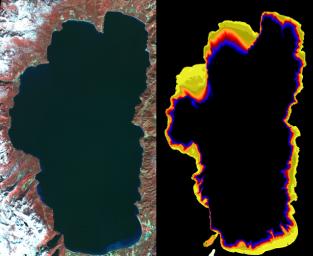Images from the Advanced Spaceborne Thermal Emission and Reflection Radiometer aboard NASA's Terra satellite, launched in 1999, illustrate the state of gradually decreasing water clarity at Lake Tahoe, one of the clearest lakes in the world. The images are available at: http://asterweb.jpl.nasa.gov/default.htm.
In the image on the left, acquired in November 2000, vegetation can be seen in red. The image on the right, acquired at the same time by a different spectral band of the instrument, is color-coded to show the bottom of the lake around the shoreline. Where the data are black, the bottom cannot be seen.
Scientists monitoring the lake's water clarity from boat measurements obtained since 1965 have discovered that the lake along the California-Nevada border has lost more than one foot of visibility each year, according to the Lake Tahoe Watershed Assessment, a review of scientific information about the lake undertaken at the request of President Clinton and published in February 2000. The most likely causes are increases in algal growth, sediment washed in from surrounding areas and urban growth and development.
By combining historical and current ground-based measurements with space measurements from new instruments like the Advanced Spaceborne Thermal Emission and Reflection Radiometer, scientists are now continuously monitoring and better understanding the circulation and changes in Lake Tahoe's water clarity. Images like these from satellites, which are able to capture entire views of the lake and its 63 contributing streams, can be used to determine and monitor spatial variations in the lake's clarity over time. These images complement "point" measurements, made by boats from one spot in the lake. Rafts and buoys verify the satellite images, and help scientists develop and test circulation models.
The Advanced Spaceborne Thermal Emission and Reflection Radiometer is one of five Earth-observing instruments on Terra, launched in 1999, and is its only high-resolution imaging sensor. Japan's Ministry of Economy, Trade and Industry built the instrument. JPL is responsible for the American side of the joint U.S.-Japan science team that is validating and calibrating the instrument and data products. The instrument will image Earth for the next four years to map and monitor the changing surface of our planet. More information on Aster is available at: http://asterweb.jpl.nasa.gov/ .
Terra is part of NASA's Earth Science Enterprise, a long-term research effort dedicated to understanding and protecting our home planet. JPL is a division of the California Institute of Technology
Size: 28 x 40 km (17.4 x 24.8 miles)
Location: 40.7 deg. North lat., 111.9 deg. West long.
Orientation: North at top
Image Data: ASTER bands 1,2, and 3.
Original Data Resolution: 15 m
Date Acquired: November 7, 2000

 Planetary Data System
Planetary Data System












